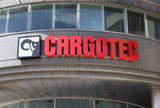 Cargotec is envisaging the way the port of the future will look with its Port 2060 project. |
Cargotec is envisaging the way the port of the future will look with the initiation of its Port 2060 project devised to spark discussion within the terminal operations sector.
Employees were invited to engage in "out of-the-box thinking" so that the company could use TOC Europe 2011 in Antwerp, Belgium to launch a vision for the future. Port 2060 aims to develop the process and ideas that will underpin containerisation in about 50 years' time.
Cargotec's senior vice president - Port Cranes, Isml Matinlauri, says it was time for the company to consider the future and "do some long-term thinking" with the cargo-handling market on the upswing.
"We asked: 'Where are we heading, what will be changed, and what could remain as it is?' This exercise is part of our ongoing drive to enhance our customers' operational performance, as we believe now is the time to start preparing for the future together."
By around 2060, the world will be celebrating the centenary of containerisation. Cargotec's Port 2060 vision suggests that over the next few decades, cargo-handling technology will keep evolving and take different forms and yet containers will keep moving cargo around the world.
By 2060, the company says, mega-ports will be located offshore on artificial islands where layouts can be optimised. These ports will be supported by floating feeder or river terminals that can be moved around in line with changing demands.
The container itself will remain in use, based on the same compact, standardised format, but different materials might be used. Containers could be foldable and may have inbuilt intelligence to communicate destination, contents and journey details.
One of the most interesting ideas generated by the Port 2060 project is that fully automatic lashing systems could form different container 'packages' with up to 64 containers in a single moveable unit. Container crane lift capacities could increase from around 40-100 T today to 1,000-2,000 T, so that they could handle such container packages in a single lift.
Container storage could take place in terminals located in underground silos, as land will be at a premium by 2060. An automated tracking system will locate and store containers as required in these terminals, which will be powered sustainably by solar panels on top of the silos.
While some current containership designs will still be in operation, the majority of container vessels of the future will be fully automated, or with very small crew, with numerous energy-saving features, including solar technology. They will also be designed so that a container block can be separated from the vessels if needed, allowing them to then pick up another cargo block and sail on.
One of the most startling concepts could be 'flying spreaders', using nano-fibre technology that by then will have replaced steel wiring. Feeder vessels will be loaded in part by these flying spreaders, facilitating last minute loading changes for instance.
Within the Port 2060 environment, automation is virtually the sole mode of operation. Artificial Intelligence, widely used in daily life in 2060, will monitor port processes, thereby optimising performance.
Cargo-handling systems will use alternative energy sources or electric drives, and wheels will have been replaced by air cushion or magnetic levitation technologies. Handling equipment will have its own 'consciousness', allowing it to monitor wear and tear, and will be able to order its own maintenance and repairs remotely. Landside handling equipment will be made up of universal modules that are fully interchangeable between different types of equipment, and will be tailored using special software solutions.
"Port 2060 is about releasing our creativity," said Matinlauri. "The future as described might be much more exotic, or less so, but we need to be prepared for change whatever direction it takes. It might seem that 2060 is a long way away, but many of those who will be celebrating the centenary of containerisation around 2060 are already alive today."
Matinlauri spearheaded the project and together with six employees formed the small team that assembled the project's basic ideas.
In May, Matinlauri challenged his colleagues to present ideas based on their work, knowledge and personal interests and awarded prizes for active participation and the most interesting ideas.
Cargotec invites everyone to join the discussion about ports of the future. Visit
www.cargotec.com/port2060 to view a movie and learn more on the topic.